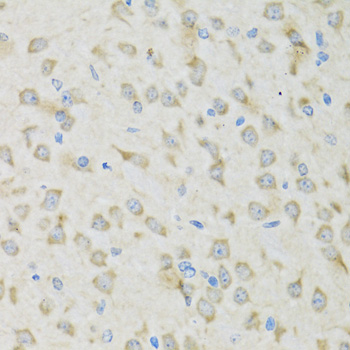Anti-CLCN7 Antibody (CAB6886)
- SKU:
- CAB6886
- Product type:
- Antibody
- Reactivity:
- Human
- Reactivity:
- Mouse
- Reactivity:
- Rat
- Host Species:
- Rabbit
- Isotype:
- IgG
- Antibody Type:
- Polyclonal Antibody
- Research Area:
- Signal Transduction
Frequently bought together:
Description
| 抗体名: | Anti-CLCN7 Antibody |
| 抗体コード: | CAB6886 |
| 抗体サイズ: | 20uL, 50uL, 100uL |
| 申し込み: | WB IHC |
| 反応性: | Human, Mouse, Rat |
| 宿主種: | Rabbit |
| 免疫原: | Recombinant fusion protein containing a sequence corresponding to amino acids 626-805 of human CLCN7 (NP_001278.1). |
| 申し込み: | WB IHC |
| 推奨希釈: | WB 1:500 - 1:2000 IHC 1:50 - 1:200 |
| 反応性: | Human, Mouse, Rat |
| ポジティブサンプル: | HL-60, SKOV3, BT-474, NCI-H460, Mouse liver, Rat liver, Rat brain, Rat brain |
| 免疫原: | Recombinant fusion protein containing a sequence corresponding to amino acids 626-805 of human CLCN7 (NP_001278.1). |
| 精製方法: | Affinity purification |
| ストレージバッファ: | Store at -20'C. Avoid freeze / thaw cycles. Buffer: PBS with 0.02% sodium azide, 50% glycerol, pH7.3. |
| アイソタイプ: | IgG |
| 順序: | TARE VMST PVTC LRRR EKVG VIVD VLSD TASN HNGF PVVE HADD TQPA RLQG LILR SQLI VLLK HKVF VERS NLGL VQRR LRLK DFRD AYPR FPPI QSIH VSQD EREC TMDL SEFM NPSP YTVP QEAS LPRV FKLF RALG LRHL VVVD NRNQ VVGL VTRK DLAR YRLG KRGL EELS LAQT |
| 遺伝子ID: | 1186 |
| Uniprot: | P51798 |
| セルラーロケーション: | Lysosome membrane, Multi-pass membrane protein |
| 計算された分子量: | 86kDa/88kDa |
| 観察された分子量: | 89kDa/110kDa |
| 同義語: | CLCN7, CLC-7, CLC7, OPTA2, OPTB4, PPP1R63 |
| バックグラウンド: | The product of this gene belongs to the CLC chloride channel family of proteins. Chloride channels play important roles in the plasma membrane and in intracellular organelles. This gene encodes chloride channel 7. Defects in this gene are the cause of osteopetrosis autosomal recessive type 4 (OPTB4), also called infantile malignant osteopetrosis type 2 as well as the cause of autosomal dominant osteopetrosis type 2 (OPTA2), also called autosomal dominant Albers-Schonberg disease or marble disease autosoml dominant. Osteopetrosis is a rare genetic disease characterized by abnormally dense bone, due to defective resorption of immature bone. OPTA2 is the most common form of osteopetrosis, occurring in adolescence or adulthood. |
| UniProt Protein Function: | CLCN7: Slowly voltage-gated channel mediating the exchange of chloride ions against protons. Functions as antiporter and contributes to the acidification of the lysosome lumen. Defects in CLCN7 are the cause of osteopetrosis autosomal recessive type 4 (OPTB4); also known as infantile malignant osteopetrosis type 2. Osteopetrosis is a rare genetic disease characterized by abnormally dense bone, due to defective resorption of immature bone. The disorder occurs in two forms: a severe autosomal recessive form occurring in utero, infancy, or childhood, and a benign autosomal dominant form occurring in adolescence or adulthood. Defects in CLCN7 are the cause of osteopetrosis autosomal dominant type 2 (OPTA2); also known as autosomal dominant Albers-Schonberg disease or marble disease autosomal dominant. Osteopetrosis is a rare genetic disease characterized by abnormally dense bone, due to defective resorption of immature bone. The disorder occurs in two forms: a severe autosomal recessive form occurring in utero, infancy, or childhood, and a benign autosomal dominant form occurring in adolescence or adulthood. OPTA2 is the most common form of osteopetrosis, occurring in adolescence or adulthood. It is characterized by sclerosis, predominantly involving the spine, the pelvis and the skull base. Belongs to the chloride channel (TC 2.A.49) family. ClC-7/CLCN7 subfamily. |
| UniProt Protein Details: | Protein type:Membrane protein, multi-pass; Transporter, ion channel; Channel, chloride; Membrane protein, integral; Transporter Chromosomal Location of Human Ortholog: 16p13 Cellular Component: membrane; lysosomal membrane; integral to membrane; cytoplasmic vesicle Molecular Function:chloride channel activity; voltage-gated chloride channel activity; ATP binding; antiporter activity Biological Process: transport; transmembrane transport; response to pH Disease: Osteopetrosis, Autosomal Dominant 2; Osteopetrosis, Autosomal Recessive 4 |
| NCBI Summary: | The product of this gene belongs to the CLC chloride channel family of proteins. Chloride channels play important roles in the plasma membrane and in intracellular organelles. This gene encodes chloride channel 7. Defects in this gene are the cause of osteopetrosis autosomal recessive type 4 (OPTB4), also called infantile malignant osteopetrosis type 2 as well as the cause of autosomal dominant osteopetrosis type 2 (OPTA2), also called autosomal dominant Albers-Schonberg disease or marble disease autosoml dominant. Osteopetrosis is a rare genetic disease characterized by abnormally dense bone, due to defective resorption of immature bone. OPTA2 is the most common form of osteopetrosis, occurring in adolescence or adulthood. [provided by RefSeq, Jul 2008] |
| UniProt Code: | P51798 |
| NCBI GenInfo Identifier: | 12644301 |
| NCBI Gene ID: | 1186 |
| NCBI Accession: | P51798.2 |
| UniProt Secondary Accession: | P51798,Q9NYX5, A6NEJ7, A8K5T9, A8K7X1, B3KPN3, E9PDB9 |
| UniProt Related Accession: | P51798 |
| Molecular Weight: | Observed MW: 89kDa/110kDaCalculated MW: 86kDa/88kDa |
| NCBI Full Name: | H(+)/Cl(-) exchange transporter 7 |
| NCBI Synonym Full Names: | chloride channel, voltage-sensitive 7 |
| NCBI Official Symbol: | CLCN7 |
| NCBI Official Synonym Symbols: | CLC7; CLC-7; OPTA2; OPTB4; PPP1R63 |
| NCBI Protein Information: | H(+)/Cl(-) exchange transporter 7; H(+)/Cl(-) exchange transporter 7; chloride channel protein 7; chloride channel 7 alpha subunit; protein phosphatase 1, regulatory subunit 63 |
| UniProt Protein Name: | H(+)/Cl(-) exchange transporter 7 |
| UniProt Synonym Protein Names: | Chloride channel 7 alpha subunit; Chloride channel protein 7; ClC-7 |
| Protein Family: | H(+)/Cl(-) exchange transporter |
| UniProt Gene Name: | CLCN7 |
| UniProt Entry Name: | CLCN7_HUMAN |
View AllClose



